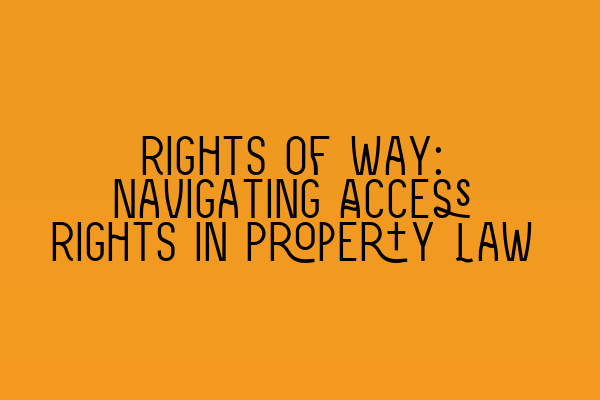Rights of Way: Navigating Access Rights in Property Law
When it comes to property law, one important aspect that often arises is the issue of rights of way. A right of way is a legal right that allows someone to pass through another person’s land or property for a specific purpose. Understanding rights of way is crucial for property owners and those wishing to access certain areas. In this blog post, we will explore the concept of rights of way, the different types, and how they are navigated in property law.
Before delving into the intricacies of rights of way, it’s important to mention that property law can sometimes be complex. To gain a comprehensive understanding of this aspect, it’s helpful to familiarize yourself with the landmark cases and influential judicial decisions that have shaped contract law. You can find more information about these cases and decisions in our article on SQE Contract Law: Analyzing Landmark Cases and Influential Judicial Decisions.
So, what exactly is a right of way? A right of way is a legal entitlement that grants someone the right to travel across a specific piece of land, even if they do not own it. This right can be established through various means, including express grants, easements, and prescriptive rights. It is important to note that rights of way can be for vehicular access, pedestrian access, or both.
One type of right of way is an express grant, which is created when the owner of the land grants permission to someone else to use a specific route across their property. This is usually done through a formal agreement, such as a contract or deed. An express grant is often the simplest and most straightforward way to establish a right of way.
Another type of right of way is an easement. An easement is a legal right that allows someone to use another person’s land for a specific purpose. This purpose can include a right of way, but it can also include other uses such as drainage, maintenance, or accessing utilities. Easements are usually created through a legal document, such as a deed, and they can be attached to the land, meaning they can continue to exist even if the property changes ownership.
Prescriptive rights of way are another form of access right in property law. These rights are acquired through long and uninterrupted use of a pathway or route. To establish a prescriptive right of way, the use must be:
1. Open and notorious – meaning the use is not secretive or hidden.
2. Continuous – meaning the use has been ongoing for a specific period of time, typically 20 years.
3. Adverse – meaning the use is without the permission of the landowner.
Unlike express grants or easements, prescriptive rights of way do not require any formal documentation. They are based solely on the historical use of the pathway.
Navigating rights of way in property law can sometimes be a complex process. It’s important to have a solid understanding of the legal principles and requirements involved. To enhance your knowledge further, you might consider exploring our article on Understanding Contractual Capacity: Rights and Limitations. This article offers insights into the rights and limitations associated with contractual agreements, which can be highly relevant when dealing with property and access rights.
Challenges can arise when establishing or dealing with rights of way. Disputes can occur between landowners and those seeking access, which may require legal intervention to resolve. In such cases, it’s beneficial to have a legal professional with expertise in property law to assist you. At SQE Property Law & Land Law, we specialize in handling property-related matters and can provide the guidance you need.
To help you better prepare and test your knowledge on property law and other aspects of contract law, we offer interactive SQE mock tests. These tests are designed to simulate the structure and difficulty level of the actual SQE exams, allowing you to assess your understanding and identify areas where you might need further study. You can find more information about these mock tests in our article on Interactive SQE Mock Tests for Contract Law: Test Your Knowledge.
In addition to mock tests, we also conduct SQE contract law webinars, where our legal experts provide valuable insights and guidance on various topics within contract law. These webinars are designed to enhance your understanding, keep you updated with the latest developments, and provide you with the tools you need to excel in your career. To learn more about our webinars and how to join, visit our article on Join Our SQE Contract Law Webinars: Expert Insights and Guidance.
In conclusion, rights of way are an important aspect of property law that can often be complex to navigate. Whether you are a property owner or someone seeking access, understanding the different types of rights of way and how they are established is crucial. If you require legal assistance or further information, SQE Property Law & Land Law is here to help. And remember, to master the essentials of property law and strengthen your knowledge, explore our resources on SQE Prep: Mastering the Essentials of Contract Law.
